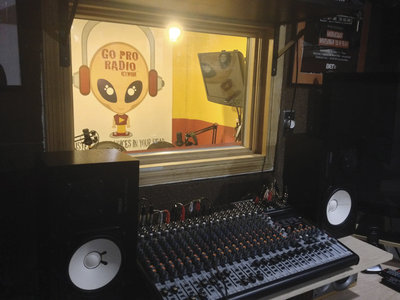By now, online radio is probably as diverse as the traditional terrestrial stations that came before it. Some stations are slick and professional, with smooth-talking hosts, while other stations sound like they were recorded in someone’s basement.
Go Pro Radio Network, which launched in Feb. 2012 and is based downtown on First Street, hit the internet with original programming designed to compete with the best that radio has to offer online, on satellite, or on earth.
“What we wanted to do is harness the best of both worlds, in terms of the model that people might typically follow with terrestrial radio, coupled with the reach of and burgeoning possibilities of internet radio, which, just in terms of the scope of the possibilities, has surpassed what terrestrial radio was,” said Go Pro Radio executive director Iyanna Jones, who founded the online station with Tylon Washington.
Jones and Washington work with veteran radio hosts and broadcasting novices with strong content ideas to develop music and talk shows that will attract an audience. At the same time, the station also sought to stay rooted in the community by including talk shows and other programming that focused on Jersey City’s political and art scenes, and that promoted local businesses in the Tri-State area, including Jersey City.
‘We had to scale back so that we could come back stronger.’ – Iyanna Jones
____________
If all this sounds ambitious for a fledgling radio network, it was, although Jones and Washington tried to grow Go Pro slowly by airing live content only twice a week, on Wednesday evenings and Saturdays. These were the days when listeners could call in, since the hosts were recording their shows live. At other times listeners could tune in to recorded shows by streaming them over the internet.
While the shows were averaging about 4,000 listeners, Jones said that keeping up with the technology required to adequately air Go Pro’s radio programming and video content proved to be “a struggle” financially.
The company went on a 15-day hiatus recently to redesign the First Street studio and streamline its programming.
“We had to scale back so that we could come back stronger,” said Jones, which meant cutting some programming and programming hours to focus on Go Pro’s most popular content. “We realized we were overreaching our capacity. In a way, we’re the only company of our kind. We’re this hybrid of service provider and mentors, as well as content developers. So, that’s a daunting challenge to take on.”
Despite the hiatus, Jones said she believes the station is now better equipped to offer better shows in the future.
For example, the station has a fitness show that is currently in development. The new studio renovations, Jones said, will allow the host to not only talk about fitness with listeners, but also demonstrate exercise routines for people who stream Go Pro’s video content. Another show under currently under consideration would focus on DJing, and the new studio can now accommodate multiple turntables, which the host could use to demonstrate different skills, again, for the radio station’s viewing public.
“This will create a wonderful visual spectacle for people who are watching in addition to listening,” said Jones, who likened the Go Pro experiment to a “multi-media movement that people can join and feel like not only are they changing the minds of the folks they’re trying to reach, but also they’re changing the way we communicate with one another.”
Jones said the station is on track to have about 34 shows up and running by the time Go Pro reaches its second anniversary in February 2014.
The Go Pro Radio Network grew out of BW Moving Images, formerly known as BlackWaxx Studios, a record label that moved from Brooklyn to Jersey City in 2001. Under its current incarnation as BW Moving Images, the company now produces films, music videos, commercials, and online content, which now includes Go Pro Radio Network.
E-mail E. Assata Wright at awright@hudsonreporter.com.
